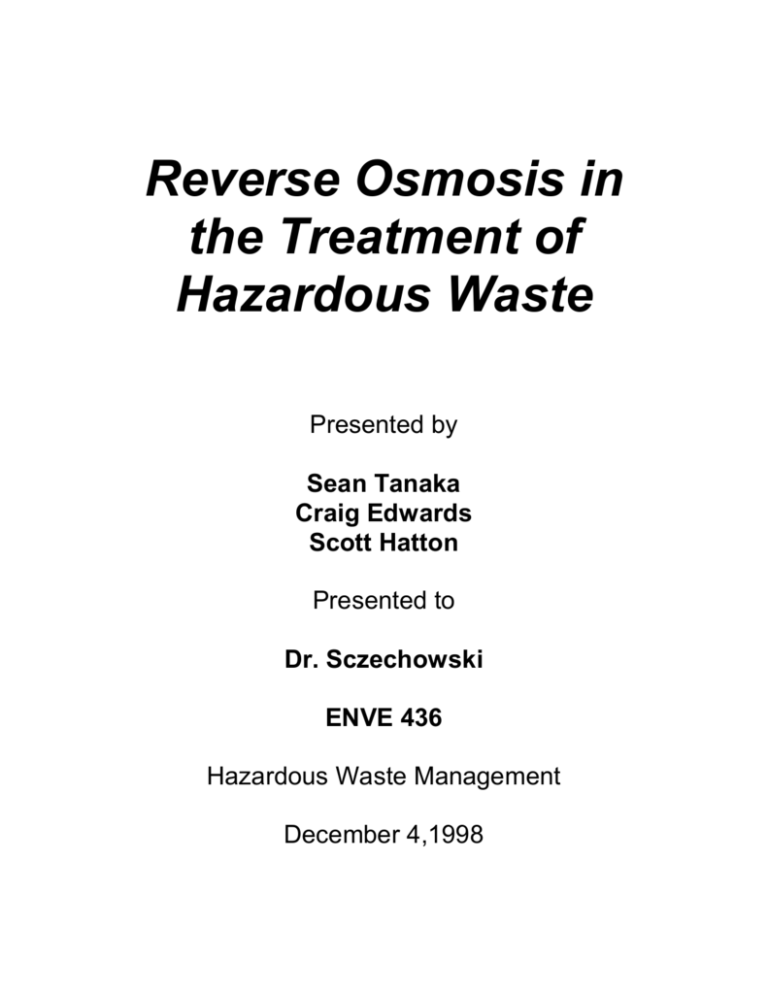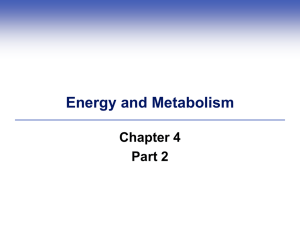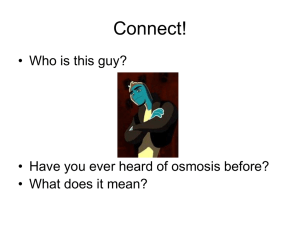Reverse Osmosis in the Treatment of Hazardous Waste
advertisement

Reverse Osmosis in the Treatment of Hazardous Waste Presented by Sean Tanaka Craig Edwards Scott Hatton Presented to Dr. Sczechowski ENVE 436 Hazardous Waste Management December 4,1998 Reverse Osmosis (RO) technology is used by many industries, including pharmaceutical and semiconductor. RO is used to purify drinking water in homes, desalinate seawater, and to remove impurities from process water. RO is used alone or with pre- and/or post-treatment equipment to meet a specified requirement for water quality. As industrial processes have changed and environmental regulations become more stringent, reverse osmosis is now used to treat hazardous waste. One such application is the concentrating of metals in rinse water in the metal plating industry. A second application is the treatment of landfill leachate and other liquids high in Total Dissolved Solids (TDS) and Volatile Organic Compounds (VOCs). When a semi-permeable membrane separates two solutions having different solute concentrations, a natural diffusion from the lower concentration to the higher concentration will take place. If one side contains fresh water and the other side contains salt water, the fresh water will diffuse to the salt water side in order to balance the concentrations on each side of the membrane. This process is called osmosis. When equilibrium is reached, there will be an osmotic pressure build up on the fresh water side that balances the concentration difference. In order to reverse this process, a mechanical pressure must be applied to the salt water side that is greater than the osmotic pressure. The change in direction of natural flow under this applied pressure is called reverse osmosis. In many commercial reverse osmosis units, operating pressures range from about 150 to 1500 pi (Geankoplis 788). 2 The value of osmotic pressure () has been experimentally determined by Van’t Hoff to be: = (n/Vm)RT Where = osmotic coefficient n = number of kg mol of solute Vm = volume of pure solvent water (m3) R = ideal gas constant = 82.057x10-3 (m3 * atm/kg mol *K) T = temperature (K) Osmotic pressure for salt water varies from 0 to 100 atm depending on the salt concentrations. There are two main types of membranes that are used in reverse osmosis, cellulose acetate and “Permasep”. The cellulose acetate membrane is 50 to 135 m thick with one film layer and one sponge layer. This membrane can filter 99% of the salts in solution and is most effective against the diffusion of sodium chloride (NaCl), sodium bromide (NaBr), calcium chloride (CaCl2), sodium sulfate (Na2SO4), sucrose, and tetralkyl ammonium salts (Geankoplis 784). Permasep is the name given to synthetic polyamide membranes made into fine hollow fibers. Permasep membranes can withstand alkali conditions. For diffusion-type membranes, the equations that represent the diffusion of solvent and solute are as follows. For diffusion of the solvent through the membrane, Nw = (Pw/Lw)(P - ) = Aw(P - ) Pw = (DwcwVw)/(RT) Aw = Pw/Lm Where: Nw = solvent flux (kg/s*m2) Pw = solvent membrane permeability (kg solvent/s*m*atm) 3 Lm = membrane thickness (m) Aw = solvent permeability constant (kg solvent/s*m 2*atm) P = hydrostatic pressure difference across membrane (atm) = osmotic pressure difference across membrane (atm) Dw = diffusivity of solvent in membrane (m2/s) Cw = mean concentration of solvent in membrane (kg solvent/m 3) Vw = molar volume of solvent (m3/kg mol solvent) R = ideal gas constant = 82.057x10-3 (m3*atm/kg mol*K) T = temperature (K) The equation representing the diffusion of the solute through the membrane is, Ns = (DsKs/Lm)c = Awc Where: Ns = solute flux (kg solute/s*m2) Ds = diffusivity of solute in membrane (m2/s) Ks = conc. of solute in membrane/conc. of solute in solution As = solute permeability constant (m/s) c = concentration difference across the membrane (kg solute/m 3) The solute rejection R is the ratio of concentration difference across the membrane divided by the concentration on the feed side. When the solvent diffuses through the membrane, there is a build-up of solute that forms at the surface of the membrane. This solute build-up is called concentration polarization (). It is defined as the ratio of the solute concentration at the membrane surface divided the concentration in the concentrate. Concentration polarization decreases the solvent flux through the membrane and increases the solute flux. This is evident in the following equations. = 1 - 2 Where: 1 = osmotic pressure of feed solution (atm) 2 = osmotic pressure of product solution (atm) Ns = As(c1 – c2) Where: c1 = concentration of feed solution (kg solute/m 3) c2 = concentration of product solution (kg solute/m 3) 4 Typical concentration polarization ratios are 1.2 to 2.0, which means that the concentration in the boundary layer is 1.2 to 2.0 times the concentration in the feed solution (Geankoplis 788). Dissolved metal salts can be removed through reverse osmosis by forcing water through a semipermeable membrane at pressures between 400 and 800 psig. RO units can concentrate most divalent metals, such as nickel, copper, cadmium, and zinc, from rinse waters to a 10 - 20% solution. According to U.S. EPA studies, the main application of RO systems in metal plating is for the concentration of rinse water from acidic nickel-plating baths. Cellulose acetate membranes are commonly used and recovery efficiencies range between 90% and 95% (Cartwright). The concentrated solution is returned to the plating bath to make up for plating and drag-out losses of the plating solution. Additionally, the clean rinse water can be reused in the rinsing phase of the process (Higgins 270). Due to the membrane's sensitivity to corrosive and oxidizing environments, average membrane life is between 1 and 3 years. RO systems have limitations in plating because the metals have high oxidation potentials and the acid baths often have a pH of less than 2.5 or greater than 11. Ambient temperature baths also pose a concentration problem because the RO system alone cannot concentrate the metals in rinse water to the strength of the plating bath solution. An evaporator is required to reach necessary concentrations for 5 reuse the plating bath (Higgins 274). The benefits to using reverse osmosis are waste reduction and/or concentration the waste for disposal. Leachate is an ongoing problem for the owners and operators of landfills. Current options for leachate management include leachate recycling, leachate evaporation, treatment followed by disposal, and discharge to municipal water systems (Tchobanoglous 440). The acceptable options are site specific and in the case of hazardous waste landfills and municipal waste landfills that accepted hazardous wastes prior to current regulations, reverse osmosis can be used to treat landfill leachate. Rochem Separation Systems, Inc. has equipment installed to treat leachate at "over 60 landfills worldwide" (EPA 52). Rochem's Disc TubeTM Module (DTM) Technology is one way that leachate can be treated, so as to concentrate the waste before removing it from a site. The United States Environmental Protection Agency evaluated Rochem's DTM at the Central Landfill in Johnston, Rhode Island. The site consists of a 121-acre disposal area where hazardous and non-hazardous wastes were accepted until April 1993. The area of concern was the "half-acre where large volumes of liquid industrial waste were disposed of in several trenches excavated into bedrock" (EPA 28). Some of the contaminants at the site were chlorobenzene at 21 mg/L and 1,2-dichlorobenzene at 16 mg/L (additional information may be found in Table 1). Table 1: Average Concentrations during DTM evaluation at Central Landfill Contaminant 1,2-Dichlorobenzene System Feed Final Permeate Final (mg/L) (mg/L) Concentrate (mg/L) 16 .76 6 23 Chlorobenzene 21 2.7 36 Toluene 1.8 0.083 3.4 Barium 1.4 <0.014 4.3 Magnesium 250 <1.6 850 Total Dissolved Solids 4,900 <32 17,000 Total Organic Carbon 5,800 <100 21,000 Source: Table 4-2 in EPA's report The DTM equipment was evaluated during August and September 1994, during which time approximately 33,000 gallons of landfill leachate was treated. The purpose of this Superfund Innovative Technology Evaluation (SITE) was to see how effective the system was "in removing organic and inorganic contaminants from the landfill leachate and in resisting fouling and scaling of the membranes" (EPA 1). The DTM is designed to treat landfill leachate, water soluble oil-based coolants, oil/water mixtures, and solvent/water mixtures (EPA 10). DTM can treat "liquid waste that is higher in dissolved solids content and contaminant levels than liquid waste treated by conventional membrane separation processes” (EPA 9). DTM's design allows it to be used as the primary treatment step as compared with conventional membrane separation processes. The EPA and Rochem deemed the evaluation a success, with "excellent removals of TOC, TDS, and metals" and approximately 90% removal of Volatile Organic Compounds (VOCs) (EPA 10). Landfill operators who chose to install similar systems can see the benefit of reduced volume of contaminated materials 7 and the ability to meet discharge requirements for metals. Additionally, concentrated contaminants can be incinerated or treated by other methods. As research continues with reverse osmosis and Rochem’s DTM technology, the process will be refined and be more effective. Each application of this technology will be different and adjustments to the process will have to be made. Reverse osmosis is an effective way to treat some liquid hazardous waste. 8 References: Cartwright, P.S. "An Update on Reverse Osmosis for Metal Finishing." Plating and Finishing. April 1984. Geankoplis, Christie J. Transport Processes and Unit Operations. New Jersey: Prentice-Hall, 1993. Higgins, T. Pollution Prevention Handbook. Boca Raton: CRC Press, 1995. LaGrega, Michael D., Phillip L. Buckingham, Jeffrey C. Evans. Waste Management. New York: McGraw-Hill, 1994. Hazardous Reynolds, Tom D. Unit Operations and Processes in Environmental Engineering. Belmont: Wadsworth, 1982. Tchobanoglous, George, Hilary Theisen, Samuel Vigil. Integrated Solid Waste Management: Engineering Principles and Management Issues. New York: McGraw-Hill, 1993. United States Environmental Protection Agency. Rochem Separation Systems, Inc. Disc TubeTM Module Technology: Innovative Technology Evaluation Report. Washington D.C. January 1998. 9







